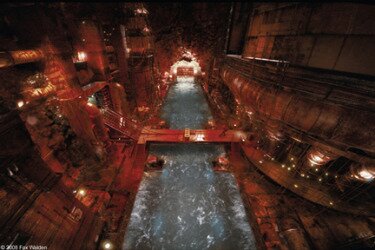Steampunk is a movement that seems to be in constant flux, there are as many definitions of what steampunk is as there are websites describing it, but at the heart of it there seems to be a few common elements: A steampunk movie tends to eschew the traditional course of the industrial revolution and makes use of anachronistic technologies that employ steam power and clockwork in a fashion that goes way beyond its traditionally accepted uses. Uh, what? Steampunk movies tend to make use of “contraptions” instead of “gadgets” and uses sets reminiscent of boiler rooms and old train stations. Even more simply: Pipes, gears and rust. Clearly, I don’t count myself as an expert in the sub-genre, but I am really into the style, kind of like how I’m really in Rube Goldberg contraptions. I guess I’m just happy that this style that I’ve enjoyed for years actually has a name. So, as the farthest thing from an expert I’m offering up 5 films that embody what I think steampunk is all about, and to truly swim out beyond my depth, I will even rate them for quality.
5. City of Ember (2008) Gil Kenan
 What’s it all about? City of Ember is post-apocalyptic story adapted from a popular book by Jeanne DuPrau about a city deep beneath the surface of the Earth meant to serve as a safe haven in the face of disaster on the surface. The story picks up 247 years after the people moved to the now decrepit city and follows two young heroes who struggle to find a way out.
What’s it all about? City of Ember is post-apocalyptic story adapted from a popular book by Jeanne DuPrau about a city deep beneath the surface of the Earth meant to serve as a safe haven in the face of disaster on the surface. The story picks up 247 years after the people moved to the now decrepit city and follows two young heroes who struggle to find a way out.
What’s so steampunk? Because the central crisis of the film seems to involve electricity more than anything else, it might be more accurate to describe this film as”electropunk” but I think that’s already a genre of music so we’ll keep it here. City of Ember makes use of two different schools of steampunk, there’s the decaying, barely functional stuff that the people of Ember have been forced to use after having dwelled in their underground refuge almost 5 decades longer than they were supposed to. And there’s the more archaic, but way more stylish machinery left behind to help people finally leave Ember and return to the surface of the Earth. Both are used to different effect, with the former illustrating a society at odds with a technology that has outlived its usefulness, and the latter hinting at the genius of previous generations and the enduring nature of their creations. While the movie itself failed to make the most of its assets, including the inimitable Bill Murray, and the puzzle sequence that involved the archaic machinery came too late, but I liked the ambience of all the Little Rascals inspired gadgetry created.
4. Back to the Future 3 (1990) Robert Zemeckis
 What’s it all about? Guitar playing time-traveller Marty “Clint Eastwood” McFly must journey back to Hill Valley in the year 1885 to find his friend Doc Brown to prevent him from being “shot in the back by Buford Tannen over a matter of 80 dollars”, and hopefully not get himself killed in the process. Somewhere along the line, Marty has to come to terms with the chip on his shoulder and Doc might even find love. Oh, and because Marty breaks the time machine getting there, much like in the first film, they have to come up with a new contraption that can get up to 88 miles per hour and take them home.
What’s it all about? Guitar playing time-traveller Marty “Clint Eastwood” McFly must journey back to Hill Valley in the year 1885 to find his friend Doc Brown to prevent him from being “shot in the back by Buford Tannen over a matter of 80 dollars”, and hopefully not get himself killed in the process. Somewhere along the line, Marty has to come to terms with the chip on his shoulder and Doc might even find love. Oh, and because Marty breaks the time machine getting there, much like in the first film, they have to come up with a new contraption that can get up to 88 miles per hour and take them home.
What’s so steampunk? It did a lot of things very wrong when measured up against its predecessors in the trilogy, but it did steampunk right, even if it wasn’t on purpose. Although much of what I’ve read about steampunk cites Jules Verne as an early influence, and who is mentioned number of times throughout the trilogy as the inspiration for Doc Brown’s work, so perhaps it was no mistake that it’s how things wrapped up. Doc’s refrigerator/ice-maker is often mistakenly referred to as a Rube Goldberg contraption, but IMHO it’s what steampunk is all about: A massive steam-powered behemoth that serves a purpose far beyond its time, and with just about as much efficiency as you’d expect. Really, having a mad scientist from the 80′s dropped in the Wild West provides all kinds of opportunities for steampunk flights of fancy, like Doc Brown’s crazy sniper scope on his rifle, and perhaps Back to the Future 3‘s greatest accomplishment of all, something you’ll never see anywhere else: The steam-powered time machine… that can fly!
3. 9 (2009) Shane Acker
 What’s it all about? A band of tiny sack-cloth humanoids fight, run, and hide from an onslaught of automated death-machines in a post-apocalyptic wasteland and somehow “protect the future” in a world where humans have been apparently been rendered extinct. It was more style than substance, but that style was totally steampunk.
What’s it all about? A band of tiny sack-cloth humanoids fight, run, and hide from an onslaught of automated death-machines in a post-apocalyptic wasteland and somehow “protect the future” in a world where humans have been apparently been rendered extinct. It was more style than substance, but that style was totally steampunk.
What’s so steampunk? 9 has been referred to as “stitchpunk”, but we don’t deal in sub-genres of sub-genres here. Besides, the little burlap heroes are likely steampunky gearwork under their skin anyway. What’s interesting is that there seems to have been a lot of steampunk style technology happening even before the apocalypse. While 9 and the other numbered figurines make use of a number of cool gadgets, the steam-powered Fabrication Machine (essentially a living, hating factory) is based on what looks like an analog style computing machine that predates the war, the analog computer being about as high tech as it gets in steampunk. There were some AT-ST looking things with Gatling guns on their noses, lots of swivelling arms, plenty of micro-zeppelin drones on patrol, and despite 9 being the titular problem solving hero, Martin Landau’s 2 and John C. Reilly’s 5 were whipping up all kinds of cool stuff. What 9 lacked in a cohesive story, it more than made up for with production design.
2. Brazil (1985) Terry Gilliam
 What’s it all about? At its most simple, Brazil is Terry Gilliam’s take on Orwell’s “1984″. When a clerical error results in the wrong man being “questioned” to death, bureaucrat daydreamer Sam Lowry finds himself swept up by a paper trail that leads him to the woman of his dreams and associating with a terrorist heating engineer. With the forces of bureaucracy crushing down on him Sam finds the only place a man can truly be free is in his dreams… If it wasn’t so funny, this would be such a sad, sad film.
What’s it all about? At its most simple, Brazil is Terry Gilliam’s take on Orwell’s “1984″. When a clerical error results in the wrong man being “questioned” to death, bureaucrat daydreamer Sam Lowry finds himself swept up by a paper trail that leads him to the woman of his dreams and associating with a terrorist heating engineer. With the forces of bureaucracy crushing down on him Sam finds the only place a man can truly be free is in his dreams… If it wasn’t so funny, this would be such a sad, sad film.
What’s so steampunk? If we count ductwork as steampunk then Brazil is the steampunkiest movie ever made. There are immense, superfluous ducts in just about every scene, with the movie’s pre-credit sequence having a commercial about decorating the drab ductwork in your home. The weird dedicated line phones that you plug into different ports for different calls, the magnified computer screens, the ridiculous “personnel transport” Sam drives and subsequently loses (which is mentioned in the charges on his death warrant), the unfathomably confounding innards of Sam’s air conditioning system churn and bubble to create something very Gilliam, but also something that strikes me as very steampunk. Gilliam’s intention seemed to be to satirize our dependence on silly gadgets by using his trademark wacky props and visuals, and in contrast to the earlier entries here, uses the steam-powered doohickeys to represent a futile pursuit rather than an ostentatious manifestation of mankind’s innate creativity… hunh? Yeah, Gilliam relies on the steampunky atmosphere here, in 12 Monkeys and maybe a little in Time Bandits too, to evoke a more pessimistic outlook while still entertaining the audience with his whimsical creations.
1. The City of Lost Children (1995) Jean-Pierre Jeunet
 What’s it all about? A superb French film from the eye-dazzling duo of Jeunet and Caro, its about a mad scientist named Krank who kidnaps children to steal their dreams because without a soul, he can’t have any of his own. When they kidnap strongman Ron Perlman’s little brother, he and a cadre of ragamuffins team up to set him free. Meanwhile, all kinds of crazy whimsical French stuff happens: Siamese twins, a flea circus organ grinder, a weird cult of cyborgs, and my second favourite Rube Goldberg sequence of all time. It has been my favourite film of all time since I laid eyes on it.
What’s it all about? A superb French film from the eye-dazzling duo of Jeunet and Caro, its about a mad scientist named Krank who kidnaps children to steal their dreams because without a soul, he can’t have any of his own. When they kidnap strongman Ron Perlman’s little brother, he and a cadre of ragamuffins team up to set him free. Meanwhile, all kinds of crazy whimsical French stuff happens: Siamese twins, a flea circus organ grinder, a weird cult of cyborgs, and my second favourite Rube Goldberg sequence of all time. It has been my favourite film of all time since I laid eyes on it.
What’s so steampunk? The stunning set design of art director Marc Caro adds a very special ingredient to the steampunk atmosphere: rust. Everything is just so worn out, like civilization opted for the steam-powered route despite being aware of its limitations, and has never been able to jump ship. There’s a brain floating in a glass box that speaks through a phonograph (not every movie that has a phonograph is steampunk, but every steampunk movie has a phonograph – test it out, I betcha I’m right) that taunts Krank. The Cyclops’ ocular implants are seemingly futuristic, but their art-deco styling and analog output are clearly anachronistic. Krank’s dream stealing machine and just about everything else in the lab of his floating fortress seem like some kind of pipe-fitter’s wet dream, with suction cups, vacuum tubes and pneumatic bladders all over the place. In much the same way that Gilliam’s contraptions were meant as a liability, the gadgetry and the surrounding environment in The City of Lost Children creates a world where people are at odds with technology – in a similar way that the people of Ember were at odds with theirs.






[...] Steve gives his top 5 “Steampunk” movies (The Film Cynics) [...]
Wow…I always liked this genre and never knew there was a name for it (or indeed that it was a genre to itself). Great post!
Welcome to The Film Cynics, Dan, and thanks!
Yeah, it’s always great when you can put a name to something you love – it means you can ask for it at a “reputable” video store. This particular post was a bit of a learning experience for me, even if I had known many of these films for a long time previous. Some honourable mentions: Steamboy, Robots, Van Helsing (maybe?), The Shadow.